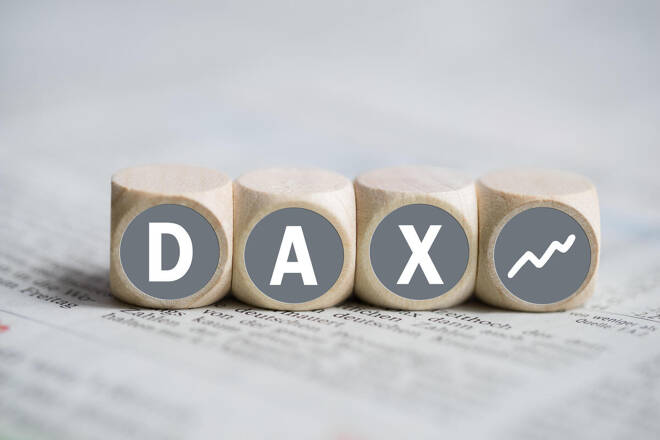Advertisement
Advertisement
Dax Index: Dax Stocks Reflect Hope as China Signals Economic Recovery
By:
With Dax stocks buoyed by China's promising data, Dax Market eyes looming Fed decisions for direction.
Highlights
- DAX concluded the week stronger, marking a 0.97% rise to settle at 15,894.
- Despite robust Chinese data, uncertainty over the nation’s economic trajectory persists.
- European markets remain wary ahead of the anticipated Federal Reserve interest rate verdict.
DAX Friday Overview
On Friday, the DAX rose by 0.56%. The DAX ended the week up 0.97% to 15,894.
China Economic Indicators Provide Friday Relief
Economic indicators from China eased fears of slower economic growth. Better-than-expected industrial production and retail sales figures flagged a much-needed pickup in demand and consumption.
Before the economic indicators, the PBoC cut the Reserve Requirement Ratio by 25 basis points. However, uncertainty about the Chinese economic outlook lingers despite the latest numbers and PBoC moves.
Eurozone Trade Data Failed to Spook Investors
In July, the Eurozone trade surplus narrowed from €18.5 billion to €6.5 billion. Economists forecast a widening to €20.0 billion. Imports from the rest of the world were down 18.2% compared with July 2022, with exports falling by 2.7% year-over-year. While the softer exports offered relief, the decline in imports signaled a weakening demand environment.
US Consumer Sentiment Wanes
A modest decline in the Michigan Consumer Sentiment Index had a limited impact on investor sentiment. However, consumer inflation expectations supported bets on the Fed ending its interest rate hike cycle.
US equities struggled despite the market sentiment toward Fed interest rates and the economic outlook. The Dow declined by 0.83%, with the S&P 500 and NASDAQ Composite Index seeing losses of 1.22% and 1.56%, respectively.
The Friday Market Movers
Auto stocks were among the front-runners, with the PBoC and the China numbers raising hopes of a pickup in demand.
BMW and Continental gained 1.66% and 1.36%, respectively. Volkswagen and Mercedes Benz Group rose by 1.07% and 1.13%, respectively. Porsche ended the session up 0.99%.
Adidas (+1.86%) joined the broader market with solid gains on sentiment toward the Chinese economy.
The Monday Session
The futures markets are pointing to a choppy start to the week. The DAX was down 2 points, while the NASDAQ gained 17 points.
Central Banks and Fed Fear to Test Investor Appetite
The European markets brushed aside the negative sentiment across the US equity markets on Friday. However, we expect investors to be mindful of the imminent Fed interest rate decision and FOMC economic projections.
Upward revisions to inflation and growth forecasts and downward revisions to unemployment would support one final Fed rate hike. However, Fed Funds Rate projections must align with any bullish FOMC projections. Uncertainty about the Fed interest rate trajectory will likely test buyer appetite.
ECB Executive Board members may also influence sentiment toward ECB monetary policy goals. Luis de Guindos and Fabio Panetta are on the calendar to speak today. The threat of further rate hikes and the talk of higher for longer could affect investor sentiment.
Short-Term Forecast
The focus will be on the Federal Reserve, the Wednesday interest rate decision, and economic projections. A high level of uncertainty regarding the November policy decision leaves the DAX at the mercy of the Fed. Fed policy uncertainty will likely limit any upside until the Fed signals its November outlook.
DAX Technical Indicators
Daily Chart
On Friday, resistance at 16,000 left the DAX short of the 16,007 resistance level. However, the DAX remained above the 50-day and 200-day EMAs, sending bullish price signals. A break above the 16,007 resistance level would support a DAX move toward the 16,192 resistance level.
However, a break below the 50-day EMA would give the bears a run at the trend line. Risk aversion would leave the 15,663 support level in view.
The 14-Daily RSI reading of 54.03 supports a DAX break above the 16,007 resistance level before entering overbought territory.
4-Hourly Chart
The DAX sits above the 50-day and 200-day EMAs, reaffirming bullish price signals. A DAX hold above the 200-day EMA would support a move to the 16,007 resistance level.
However, a break below the 200-day EMA would bring the 50-day EMA and the trend line into play. Buying pressure will likely intensify at 15,800, with the 50-day EMA confluent with the trend line.
The 58.36 RSI reading indicates a DAX return to 16,000 before entering overbought territory.
For a look at the economic events, check out our economic calendar.
About the Author
Bob Masonauthor
With over 28 years of experience in the financial industry, Bob has worked with various global rating agencies and multinational banks. Currently he is covering currencies, commodities, alternative asset classes and global equities, focusing mostly on European and Asian markets.
Advertisement
